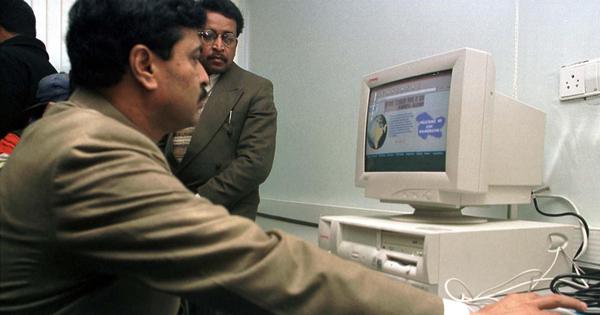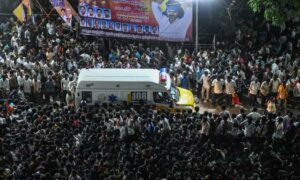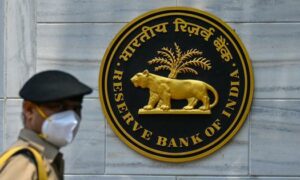
At the time of his untimely death in 2006, Pramod Vyankatesh Mahajan was widely eulogised as a “gadget-obsessed moderniser of Indian politics”, a “tireless strategist”, “India’s first modern spin doctor” and a “dynamic leader” who, in addition to his “charisma and oratorical skills”, also possessed unparalleled “organisational and tactical skills” and “number crunching” abilities. Such distinctions bestowed upon him in his obituaries highlight his unique role among all BJP leaders as a modern, technology-friendly politician who was responsible for making the BJP “a lot more compatible with the digital age”. His influence is therefore writ large in the story of the BJP’s internal professionalisation.
Mahajan was born in Mahaboobnagar, Andhra Pradesh, in 1949 and grew up in Ambajogai, a small town in Maharashtra, where he joined an RSS shakha at a relatively young age. After completing undergraduate degrees in physics and journalism, Mahajan briefly worked as the sub-editor for Tarun Bharat (a Sangh-affiliated Marathi periodical) during 1970–1971 and thereafter as a school teacher from 1971 to 1974. In 1974, he became a full-time RSS pracharak and was deputed to the BJS for organisational work. During the emergency period, he was imprisoned for his participation in the anti-government protests, during which time he also read for a master’s degree in political science. After the establishment of the BJP in 1980, Mahajan quickly emerged as one of the most promising young leaders of the party.
His organisation prowess first came to the fore during LK Advani’s rath yatra, where he was responsible for planning and managing the logistical affairs. Among his many contributions during the yatra, he installed fax machines in the local BJP offices that lay along the route of Advani’s rath, which then enabled him to send hourly press releases to the central BJP office in New Delhi that fed into news reports in mainstream media.
Despite his early socialisation in the worldview of the Sangh Parivar, he did not appear to share the organisation’s principled distance from either politics or mass media. Much before the BJP had come to rely on the use of audio–video cassettes for political mobilisation, during the 1984 general election campaign, Mahajan, contesting from the Bombay North-East constituency, was already making an active use of cassettes in his election campaign. Justifying the use of political marketing techniques for the purpose of mobilisation, Mahajan declared:
“I think it is time we stopped shying away from words such as ‘sell.’ We must realise there has been a major revolution in communication. If we maintain that a good ad campaign can’t sell a bad product, conversely people will never purchase a good product if they don’t know about it.”
In the early 1990s, Mahajan was also in charge of the BJP’s election cell, where he took on the responsibility for the overhaul of the party’s media strategy. The 1990s were a dynamic period for the media landscape in India. In exploiting this new media network, Mahajan believed that the BJP would be able to “reach the last voter” in every corner of India. In a series of organisational changes, Mahajan supervised the “modernisation” of party officers throughout the country by introducing the use of computers, setting up “media cells” with a centralised communication network and organising “media workshops” for party workers. The late 1990s also witnessed the rise of 24-hour television news channels in India, which provided politicians with greater media coverage than ever before. Finding itself woefully unprepared to compete with the more media-friendly INC, the BJP undertook large-scale training of all its party spokespersons who appeared in television news debates. It also elicited the help of independent media professionals for training its spokespersons.
In the 1990s, the BJP also embarked upon a strategy of profiling constituencies throughout the country and creating a computerised database with information on past electoral trends. In the run-up to the 1996 election, the BJP’s Maharashtra state unit acquired a special “political management software” designed by SR Badawe, a Canada-based software engineer and presumably a BJP supporter. The software contained constituency-level data on voters segregated along the lines of age, sex, caste and religion, collated together with information on the number of schools, colleges, cooperative banks, religious institutions, civic and communal problems, and geographical details in each constituency.
The BJP supplemented this software by combining it with data on party members, along with their educational profile, demographic information and work experience in political life. It is unclear how far this software was used by the party leadership and whether the information contained therein was genuine. However, what is significant is that the BJP began publicly embracing the same organisational changes and electoral tactics for which it had criticised the INC nearly a decade back. For many within the party, a public embrace of technology and media was necessary to symbolically signal to the voters that the BJP was a “modern” party, and party functionaries like Mahajan believed that “symbolism [of such electioneering] has its own impact” on the voters.
This growing sensitivity to voter profiling also points towards the fact that along with the modus operandi of electoral politics, the content and practice of politics followed by the BJP was itself undergoing subtle shifts. Although the BJP had initially come to power by claiming to represent the interests of a cohesive Hindu community, by the mid-1990s, the “Mandalisation” of Indian politics had compelled the party to contend with the calculus of caste arithmetic to win elections. As appeals to a cohesive and homogeneous Hindu community provided diminishing returns at the ballot box, the BJP realised that it had to adopt a more variegated approach of building local caste coalitions to expand its electoral footprint in different parts of the country.
In the 1990s, KN Govindacharya, then a general secretary of the BJP, was one of the first to highlight that the BJP needed to broaden its appeal among the lower castes. As a result, the party came to depend upon techniques such as voter profiling and frequently solicited the opinions of independent pollsters to gauge the mood of the electorate and to design more context-specific campaign strategies. During the 1996 general election, Mahajan justified the BJP’s reliance on pollsters by claiming that they helped provide a more accurate and reliable assessment of a party’s fortunes, whereas relying solely on party networks could result in biases. Findings from the opinion polls were then used to create targeted advertisement campaigns and plan public meetings.
By this point, reposing faith in this new style of electioneering was not just Mahajan, but an entire generation of younger party leaders. This set of younger leaders included the late Arun Jaitley, who started out as an ABVP activist in the 1970s and quickly became one of the rising stars of the BJP in the 1990s. Apart from serving as the president of the BJYM, a member of the BJP’s National Executive, party spokesperson, general secretary and a cabinet minister in the Vajpayee government, Jaitley’s skills in media management and as a “spin doctor” during election campaigns were widely recognised. Indicating his belief in the need to balance ideological purity with a dose of pragmatism and guile, he once argued:
“If a private poll says the lack of development is the key issue in [a state], it would be foolish to run a campaign on Hindutva.”
Embracing its identity as a modern, media-savvy party, in 1998 the BJP also became the first political party in India to launch its own website, where it provided users with information on the party’s history and philosophy, organisational set-up, recent news, campaign-related updates and biographical profiles of party leaders. The website also had a discussion forum called “Janmat” (People’s Opinion), where BJP supporters could leave comments and questions. This webpage briefly became a cause célèbre during the 1998 election campaign, when some users left communally inflammatory anti-Muslim messages on the online discussion board – an occurrence that foreshadows how social media would subsequently become a potent tool for hate speech for Hindu nationalists.
In the 2003 state assembly election in Rajasthan, Mahajan proved his abilities as a proficient campaign manager when he introduced the concept of “war rooms” in the BJP’s organisational matrix. Drawing inspiration from election campaigns in the US and the UK, these war rooms served as the central coordinating points for all election-related activities and were noted for their technological and methodical management procedures. Commenting on the 2004 general election, where he was in charge of the BJP’s campaign and election management, Mahajan noted:
“This is the first election of the 21st century…. Slowly, in 20–25 years – maybe not in the next 5–10 years – roadshows, yatras, public meetings and other traditional forms of campaigning will all be done on the electronic media. How you present yourself on television, how you look, how you dress, how you talk will be the main thing.”
Amogh Dhar Sharma is a Leverhulme Early Career Fellow at the Oxford Department of International Development, University of Oxford. His first book, The Backstage of Democracy, has been longlisted for the 2025 NIF Kamaladevi Chattopadhyay Book Prize.
Excerpted with permission from The Backstage of Democracy: India’s Election Campaigns and the People Who Manage Them, Amogh Dhar Sharma, Cambridge University Press.
This article first appeared on Scroll.in
📰 Crime Today News is proudly sponsored by DRYFRUIT & CO – A Brand by eFabby Global LLC
Design & Developed by Yes Mom Hosting






